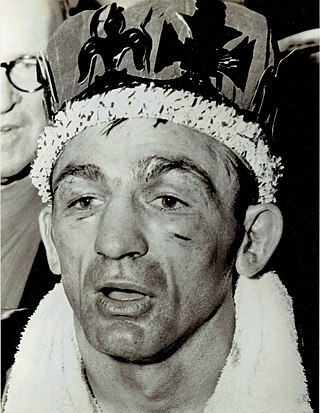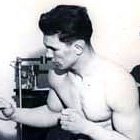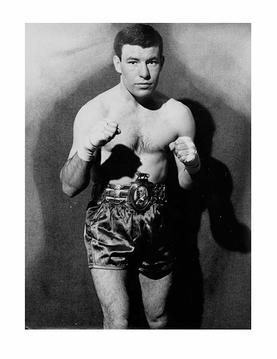
Thomas Hearns is an American former professional boxer who competed from 1977 to 2006. Nicknamed the "Motor City Cobra", and more famously "The Hitman", Hearns's tall, slender build and oversized arms and shoulders allowed him to move up over fifty pounds in his career and become the first boxer in history to win world titles in five weight divisions: welterweight, light middleweight, middleweight, super middleweight and light heavyweight.

Walker Smith Jr., better known as Sugar Ray Robinson, was an American professional boxer who competed from 1940 to 1965. He was inducted into the International Boxing Hall of Fame in 1990. He is often regarded as the greatest boxer of all time, pound-for-pound.

Henry Jackson Jr. was an American professional boxer and a world boxing champion who fought under the name Henry Armstrong.

Carmen Basilio was an American professional boxer who was the world champion in both the welterweight and middleweight divisions, beating Sugar Ray Robinson for the latter title. An iron-chinned pressure fighter, Basilio was a combination puncher who had great stamina and eventually wore many of his opponents down with vicious attacks to the head and body.

Tony Canzoneri was an American professional boxer. A three-division world champion, he held a total of five world titles. Canzoneri is a member of the exclusive group of boxing world champions who have won titles in three or more divisions. Canzoneri fought for championships between bantamweight and light welterweight. Historian Bert Sugar ranked Canzoneri as the twelfth-greatest fighter of all time.

José Ángel Nápoles was a Cuban-born Mexican professional boxer. He was a two-time undisputed welterweight champion, having held the WBA, WBC, and The Ring welterweight titles between 1969 and 1975. He is frequently ranked as one of the greatest fighters of all time in that division and is a member of the International Boxing Hall of Fame. His record of the most wins in unified championship bouts in boxing history, shared with Muhammad Ali, was unbeaten for 40 years. After debuting professionally in Cuba, he fought out of Mexico and became a Mexican citizen.
During the 1960s, boxing, like mostly everything else around the world, went through changing times. Notable was the emergence of a young boxer named Cassius Clay, who would, in his own words shock the world, declare himself against war, and change his name to Muhammad Ali.

Lawrence Gene Fullmer was an American professional boxer and World Middleweight champion. He was known as TheUtah Cyclone, The Mormon Mauler, and as "Cyclone" Gene Fullmer.
Mike McCallum is a Jamaican former professional boxer who competed from 1981 to 1997. He held world championships in three weight classes, including the WBA super welterweight title from 1984 to 1988, the WBA middleweight title from 1989 to 1991, and the WBC light heavyweight title from 1994 to 1995.

Harry Lewis, was an American boxer, generally credited with holding the Welterweight Championship of the World from April 1908 to March 1911. He defeated "Young Joseph", the reigning Welterweight Champion of England in London on June 27, 1910, but was not credited with the British Welterweight championship as the fight was sanctioned as a World, and not English title. Boxing writer Nat Fleischer rated Lewis the sixth-greatest welterweight of all time. He was inducted into the International Jewish Sports Hall of Fame in 2002, and into the International Boxing Hall of Fame in 2008.
Denny Moyer was an American boxer who held the world light middleweight title between 1962 and 1963. He finished his career with a 98–38–4 record.

Alfons Mello Tavares was an American Olympic and professional boxer who was a contender for the world middleweight title in 1929-30. He held the New England Welterweight title during his career.

Brian Nancurvis, who fought under the name Brian Curvis as a professional, was a boxer from Swansea, Wales who was active from 1959 to 1966. He fought as a Welterweight, becoming British welterweight champion in 1960. He retired as undefeated champion and is the only welterweight to have won two Lonsdale Belts outright. The four defeats in his professional career were all to foreign boxers; he was never beaten by a British boxer.
Edward George Connors, also known as "The Bulldog", was an American associate of the Winter Hill Gang and successful bar owner in Savin Hill.
Thomas Sullivan, also known as "Tommy", and "Irish Tommy" was an American professional light heavyweight boxer whose murder remains unsolved.

John Michael Basham was a Welsh boxer who became British and European champion at both welter and middleweight. His professional career spanned over 20 years, from 1909 to 1929, and after being stationed in Wrexham through military service, he fought most of his bouts in nearby Liverpool.

Herbert Lewis Hardwick Arroyo, also known as "Cocoa Kid", was a Puerto Rican boxer of African descent who fought primarily as a welterweight but also in the middleweight division. Hardwick won the World Colored Championships in both divisions. He was a member of boxing's "Black Murderers' Row" and fought the best boxers of his time. He was inducted into the International Boxing Hall of Fame in 2012.
Kofi Jantuah is a Ghanaian professional boxer that fights at middleweight. He was born in Kumasi, Ghana and now lives in Las Vegas.

Mike "Twin" Sullivan was an American boxer credited with taking the Welterweight Championship of the World on April 23, 1907, when he soundly defeated William "Honey" Mellody in Los Angeles in a twenty-round bout. He vacated the title in the late fall of 1908, when he could not make weight.

William "Honey" Mellody was an American boxer who took the Welterweight Championship of the World on October 16, 1906, defeating former champion Joe Walcott in a fifteen-round points decision in Chelsea, Massachusetts.












